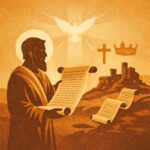| Host: | Mathilde Frey |
|---|---|
| Guests: | Alex Bryan and Andreas Beccai |
| Quarter: | Themes in the Gospel of John |
| Lesson: | 12 |
| Sabbath: | December 21st, 2024 |
Relevant Verses: John 18:33–19:5; 19:17–27; 20:1–18
Theme: The Crucified and the Risen Jesus
In his book Night, Elie Wiesel describes a scene from the concentration camp in Auschwitz:
One day, as we returned from work, we saw three gallows, three black ravens, erected on the Appelplatz. Roll call. The SS surrounding us, machine guns aimed at us: the usual ritual. Three prisoners in chains – and, among them, the little pipel, the sad-eyed angel. The SS seemed more preoccupied, more worried, than usual. To hang a child in front of thousands of onlookers was not a small matter. The head of the camp read the verdict. All eyes were on the child. He was pale, almost calm, but he was biting his lips as he stood in the shadow of the gallows.
This time, the Lagerkapo refused to act as executioner. Three SS took his place. The three condemned prisoners together stepped onto the chairs. In unison, the nooses were placed around their necks. “Long live liberty!” shouted the two men. But the boy was silent.
“Where is merciful God, where is He?” someone behind me was asking.
At the signal, the three chairs were tipped over. Total silence in the camp. On the horizon, the sun was setting.
“Caps off!” screamed the Lageralteste. His voice quivered. As for the rest of us, we were weeping.
“Cover your heads!”
Then came the march past the victims. The two men were no longer alive. Their tongues were hanging out, swollen and bluish. But the third rope was still moving: the child, too light, was still breathing… And so he remained for more than half an hour, lingering between life and death, writhing before our eyes. And we were forced to look at him at close range. He was still alive when I passed him. His tongue was still red, his eyes not yet extinguished.
Behind me, I heard the same man asking: “For God’s sake, where is God?”
And from within me, I heard a voice answer: “Where is He? This is where – hanging here from these gallows.”
The Cross
This brief commentary focuses on those features in the crucifixion narratives that are unique to the Gospel of John:
- In John’s Gospel, Jesus carries his own cross. There is no Simon of Cyrene compelled to assist Jesus when he is weak from flogging by carrying the crossbar to the crucifixion site.
- The account of the crucifixion is briefly narrated, “when the soldiers had crucified Jesus” (John 19:23). The brevity with which Jesus’ crucifixion is described is similar to the descriptions of Jesus’ signs. The sign, here the crucifixion itself, is not the primary focus, but what happens around it, the details and the dialogue.
- Mary, the mother of Jesus, appears only two times in the Gospel of John, first at the wedding at Cana and then at the cross. She brackets the life of Jesus, demonstrating his humanity and the need for her presence. Without her Jesus would be alone. He does not cry to his father from the cross, but he needs his mother, who has been there for him from the first sign to the last. The mother of Jesus is the Gospel’s embodiment of what abiding means and looks like. It is about being there.
- The disciple whom he loved, similarly, signifies that discipleship is first and foremost about abiding, about relationship, about presence. Anything short of that presence is theologically insufucient for the Gospel of John.
- “I am thirsty” (John 19:28). Unlike in the Synoptics, here Jesus asks for a drink. He utters a basic human need, but one that he is able to fulfill (John 4). In this way again, the Gospel of John holds together theologically Jesus’ humanity and Jesus’ divinity.
- “It is finished” (John 19:30). Everything is brought to its intended goal. The totality of Jesus’ purpose of making God known as God in the flesh who lays down his life.
The Resurrection
We, the readers of John’s Gospel, have not witnessed the resurrection. None of us claim to have been present at the empty tomb. However, because we hear the news, we are more blessed than the eyewitnesses, as Jesus says, “Blessed are those who have not seen but have come to believe” (John 20:29).
John makes it clear that the account of the resurrection begins in a garden, where Mary Magdalene confused Jesus for the gardener. We’ve already learned that everything in John’s Gospel has a purpose. This includes Mary who does not instantly recognize the gardener as Jesus, but she will when she hears his voice calling her by name. Again, the power of the Word is at work (see John 1:1-3). Gardeners, after all, cultivate life; they work with the old to raise up the new, and only God can raise up a body from the dirt (“human from the dust of the ground,” in Hebrew, adam from adamah, Gen 2:7). “Gardeners are in fact practitioners of resurrection, of bringing forth new life from below, from out of the rich, decaying, organic soil. The human from the humus” (William P. Brown, Sacred Sense, p. 135).
“By recalling the first garden in his resurrection account, John invites us to wonder, to imagine new life, resurrection, in this second garden. … Mary’s mistake is no mistake after all. John has her testifying to the saving, creative, resurrecting presence of God even before she recognizes Jesus as the resurrected one” (William P. Brown, Sacred Sense, p. 135).





